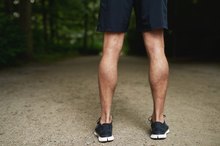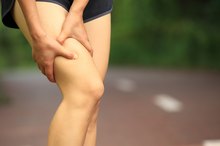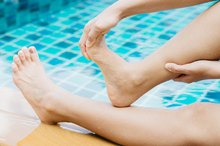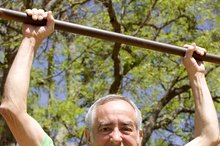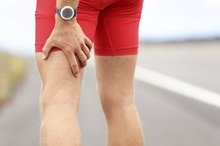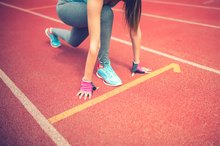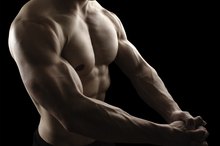Aching Legs and Calves After Exercise
Leg pains and aches, especially in the calf region, are common after intense exercise. The pain you're experiencing is probably due to dehydration, overuse or muscle strain because the particular muscles you used hadn't been exercised in a while. A few home remedies can have your aches and pains feeling better in just a few days, but if you're in extreme pain, beyond sore or achy muscles, be sure to contact your doctor.
Dehydration
If you feel muscle cramps in your legs or calves, the source of the problem could be dehydration. Dehydration is a common cause of achy muscles and occurs when you're not consuming enough fluids or if you sweat out too much liquid during exercise. Drink fluids steadily throughout your exercise to reduce the risk of dehydration. If you do become dehydrated, or notice aches and pains during or after exercise, drinking an electrolyte drink can aid your rehydration.
Torn Muscle
Hyperextension of the Calf
Learn More
The muscles most often strained are the muscles in your legs, including your calf muscles, quadriceps and hamstrings. A muscle strain, also known as a muscle tear, is characterized by tenderness to touch and swelling of the muscle. Muscle strain is graded in three levels: a grade one muscle strain means the muscle is tender to touch and slightly swollen, while a grade three muscle strain means you have extreme pain and strength is completely lost in the muscle. A grade two muscle strain is in between the two and indicates moderate pain and swelling. If you feel extreme pain in your leg or calf muscles after exercise, it's best to consult your doctor for treatment.
Overuse
If you're feeling mild or moderate aches and pains after an exercise that you haven't done in a while, your muscles are probably sore because you didn't condition them properly for the exercise you performed. If you spent eight hours on the ski hill and haven't skied since last season, your muscles aren't used to the demands of skiing and will undoubtedly ache afterward. Any time you jump into exercising without the proper preparation, you're going to have to deal with the consequence of achy legs. Never jump into exercise without conditioning for it ahead of time and always stretch before and after exercise to loosen your muscles and prevent injury.
Home Remedies
Exercises for a Torn Quad
Learn More
Treatment for these most common causes of aches and pains in your legs after exercise can usually be done in the comfort of your home. The best thing you can do for a strained or overused muscle is keep from injuring it further by giving it a rest. Ice the injury with an ice pack to reduce the swelling. To prevent burns, never apply an ice pack directly to your skin -- a T-shirt or towel wrapped around the ice pack will work fine. Bandage the injured leg muscle during the day to protect the injury from further injury and prevent more swelling. Remove the bandage before bed at night and elevate the leg while you sleep. After two to three days of rest for the muscle, perform a similar exercise to continue building strength in the muscles you used. Once your leg muscles are used to the exercise, they'll no longer be sore and achy afterward.
Related Articles
References
Writer Bio
Courtney McCaffrey graduated from the College of Charleston in 2008 with a B.A. in media studies. She has served as an editor for Blooming Twig Books and the MADA Writing Services publishing company. She is now a writer on various outdoor sports such as snowboarding, skiing, surfing and bodysurfing.
